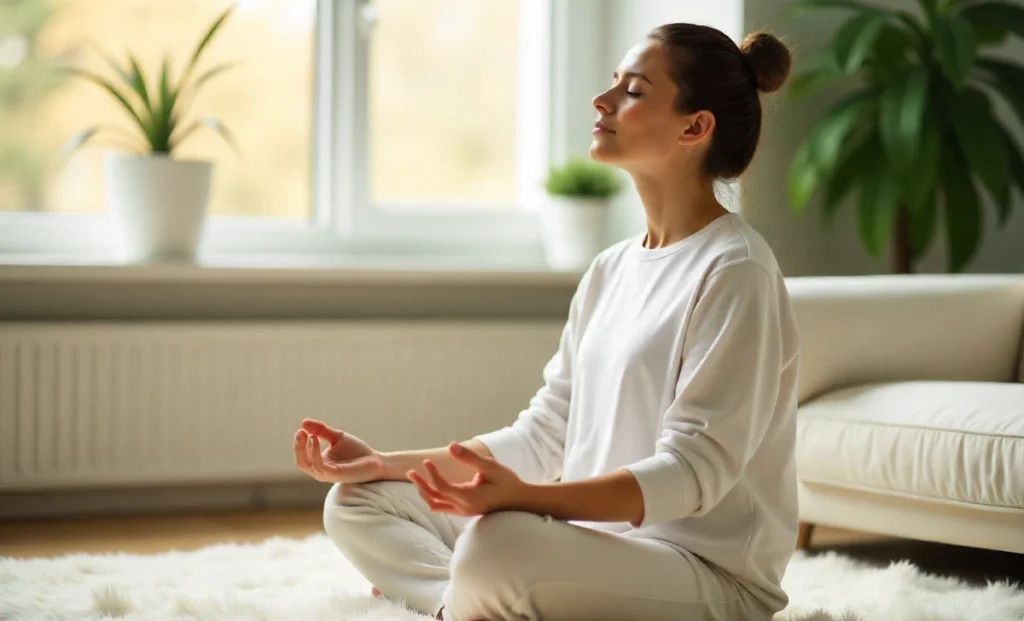I’ve been there—heart racing, mind spinning, feeling like I’m drowning in my own stress.
You know that feeling when everything piles up at once? Work deadlines, family drama, bills, and that nagging voice in your head that won’t quit.
The good news? I’ve discovered that stress relief techniques that actually work are everywhere, and most of them don’t cost a dime.
Let me share what I’ve learned about finding and using the most effective methods to calm your mind and body.
Why Most People Struggle to Find Effective Stress Relief
Here’s the truth—most of us try random techniques without understanding what actually works for our specific situation.
I used to jump from one stress relief method to another, never giving anything enough time to work.
The problem isn’t that effective techniques don’t exist. The problem is we don’t know where to look or how to choose what fits our lifestyle.
Research from Harvard Medical School shows that consistent practice matters more than finding the “perfect” technique.
Science-Backed Stress Relief Techniques You Can Start Today
Deep Breathing: Your Instant Reset Button
I discovered deep breathing during a particularly stressful work meeting, and it literally saved my sanity.
Here’s what happens: When you breathe slowly and deeply, your nervous system gets the message that you’re safe.
Your heart rate slows down, blood pressure drops, and those stress hormones start to chill out.
The technique is simple: breathe in for 4 counts, hold for 4, breathe out for 6.
I do this anywhere—in traffic, before presentations, even in the grocery store checkout line.
Mindfulness Meditation: Training Your Brain to Stay Calm
Mindfulness isn’t about emptying your mind or sitting cross-legged for hours.
It’s about noticing what’s happening right now without getting swept away by it.
I started with just 5 minutes a day using a simple meditation app.
The science is solid: Studies show regular mindfulness practice actually changes your brain structure, making you more resilient to stress.
You can practice mindfulness while washing dishes, walking, or even during your morning coffee.
Progressive Muscle Relaxation: Release Physical Tension
This technique taught me how much stress I was carrying in my body without realizing it.
Here’s how it works: You tense and then relax different muscle groups, starting from your toes and working up.
I usually do this before bed, and it helps me sleep better too.
The whole process takes about 15 minutes and leaves you feeling like you just had a massage.
Physical Exercise: Nature’s Stress Buster
Exercise isn’t just good for your body—it’s like hitting a reset button for your stressed-out brain.
I’m not talking about becoming a gym rat overnight.
Even a 10-minute walk can flood your system with mood-boosting endorphins and clear your head.
Dancing in your living room, doing jumping jacks, or stretching all count.
The key is moving your body regularly, not perfectly.
Digital Tools and Apps That Actually Help
Meditation Apps Worth Downloading
I’ve tried dozens of meditation apps, and here are the ones that actually deliver:
Headspace: offers guided meditations specifically for stress, anxiety, and sleep.
Calm: has everything from 3-minute breathing exercises to hour-long sleep stories.
Insight Timer: gives you access to thousands of free meditations from teachers worldwide.
Most apps offer free trials, so you can test what works for your schedule and preferences.
Stress-Tracking Features
Your smartphone probably has built-in stress tracking features you didn’t know about.
Apple Watch: can detect elevated heart rates and prompt you to do breathing exercises.
Android phones: often include mindfulness reminders and meditation timers.
These tools help you notice stress patterns and remind you to use your techniques.
Quick Fixes vs. Long-Term Stress Management
When You Need Immediate Relief
Sometimes you need stress relief right now, not after weeks of practice.
Quick techniques that work in minutes:
- 4-7-8 breathing (breathe in for 4, hold for 7, out for 8)
- Cold water on your wrists and face
- Listening to calming music with headphones
- Stepping outside for fresh air
- Doing 10 jumping jacks or pushups
I keep a mental toolkit of these quick fixes for emergency situations.
Building Long-Term Resilience
Real stress management means building habits that prevent stress from overwhelming you in the first place.
This includes regular exercise, good sleep habits, and social connections that support you.
For comprehensive health tips that complement stress management, these foundational wellness strategies work together.
I’ve learned that journaling for just 5 minutes each morning helps me process emotions before they build up.
Yoga, tai chi, or qigong combine movement with mindfulness for double the stress-busting power.
Setting boundaries with technology, work, and toxic relationships also makes a huge difference.
How to Choose Techniques That Fit Your Lifestyle
Consider Your Schedule
If you’re always rushing, don’t pick techniques that require 30 minutes of quiet time.
Busy people benefit from:
- Breathing exercises during commutes
- Walking meetings instead of sitting in conference rooms
- Micro-meditations between tasks
I do breathing exercises while my coffee brews and stretch while watching TV.
Match Techniques to Your Personality
If you’re active, try running, dancing, or sports for stress relief.
If you prefer quiet activities, journaling, reading, or gentle yoga might work better.
Some people need social stress relief like talking with friends or joining group classes.
Others recharge alone with music, art, or nature.
Pay attention to what naturally feels good and build from there.
Start Small and Build Up
The biggest mistake I made was trying to overhaul my entire life at once.
Start with one technique for one week. If it helps, add another.
Consistency with small steps beats sporadic attempts at major changes.
I began with 3 deep breaths before meals and gradually added other practices.
Expert-Backed Lifestyle Changes That Reduce Stress
Sleep: Your Foundation for Stress Resilience
Poor sleep makes everything more stressful, and stress makes sleep harder.
Create a bedtime routine that signals your brain it’s time to wind down.
I turn off screens an hour before bed and do gentle stretches or read.
Most adults need 7-9 hours, and yes, it really does make a difference in how you handle stress.
Nutrition That Supports Your Nervous System
What you eat affects how you feel, especially during stressful times.
Foods that help: Dark leafy greens, fatty fish, nuts, seeds, and whole grains support brain health.
Foods that hurt: Too much caffeine, sugar, and processed food can increase anxiety and stress.
I noticed a big difference when I started eating regular meals and staying hydrated.
Social Connections as Stress Medicine
Humans are wired for connection, and isolation makes stress worse.
Having people to talk to literally changes your body’s stress response.
This doesn’t mean you need a huge social circle—even one trusted friend or family member helps.
Online communities, support groups, or volunteering can provide connection too.
Making Stress Relief a Habit, Not a Chore
Link New Habits to Existing Ones
I do deep breathing while my morning coffee brews and journal right after brushing my teeth.
This “habit stacking” makes new practices feel automatic instead of forced.
Pick something you already do daily and add a stress relief technique to it.
Track What Works
Keep a simple note in your phone about which techniques help and when.
After a few weeks, you’ll see patterns that help you choose the most effective methods.
I discovered that morning stretches prevent afternoon stress better than evening workouts for me.
Be Patient with Yourself
Some techniques work immediately, others take weeks to show benefits.
Meditation felt weird for the first two weeks, then suddenly I craved that quiet time.
Don’t give up on something just because it doesn’t feel natural at first.
Conclusion: Your Stress Relief Toolkit
The most effective stress relief techniques are the ones you’ll actually use consistently.
Start with one or two methods that fit naturally into your current routine.
Breathing exercises and short walks work for almost everyone and require no special equipment.
Build your toolkit gradually by adding techniques that address both immediate relief and long-term resilience.
Remember, managing stress is a skill that improves with practice, not a problem you solve once.
The best stress relief techniques are already within your reach—you just need to know where to find them and how to use them consistently.
Frequently Asked Questions
How quickly should I expect stress relief techniques to work?
Some techniques like deep breathing work within minutes, while others like meditation and exercise show bigger benefits after 2-4 weeks of regular practice.
What if I don’t have time for stress relief techniques?
The busier you are, the more you need stress relief. Start with 30-second breathing exercises or walking while you talk on the phone. Even micro-practices help.
Are expensive stress relief programs worth it?
Many effective techniques are free or low-cost. Try free apps, YouTube videos, and simple breathing exercises before investing in expensive programs.
Can I combine different stress relief techniques?
Absolutely! Combining techniques often works better than using just one. Try pairing deep breathing with walking or mindfulness with gentle stretching.
What if nothing seems to work for my stress?
If stress is severely impacting your daily life, consider talking to a healthcare provider. Sometimes underlying issues like anxiety disorders need professional support alongside self-help techniques.
How do I know which stress relief technique is right for me?
Experiment with different methods for at least a week each. Pay attention to what feels natural and what you look forward to doing. The right technique should feel helpful, not stressful.







